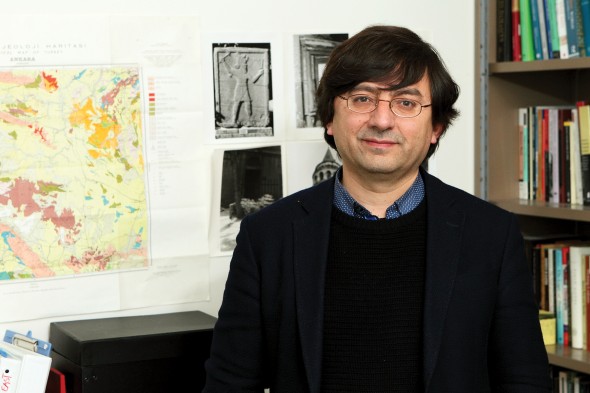Architecture, archaeology of the ancient Middle East

“Having some impact on the world, on the lives of people with my writing, was kind of my dream all along,” says Ömür Harmanşah. (Photo: Jenny Fontaine)
Art, Architecture
& the Humanities
Rising Star
When Ömür Harmanşah was growing up in Turkey, he was able to understand the landscape and history of his birthplace as he and his siblings followed his parents, who worked for the state and constantly moved when their postings changed.
He credits the influence of his father, an agricultural engineer, and his mother, a library scientist, with helping spawn his dream to study and chronicle the world around him.
“Becoming an academic and having some impact on the world, on the lives of people with my writing, was kind of my dream all along,” said Harmanşah, associate professor of art history.
Harmanşah, who calls himself an “architectural historian and landscape archaeologist,” focuses on the ancient Middle Eastern and the Eastern Mediterranean world with special attention to modern day Turkey, Iraq and Syria. He has published extensively and is currently working on a book on the politics of ecology in the Middle East.
He also writes on the social media representations of the “destruction of antiquities and archaeological museums in the Middle East, and the precarious state of cultural heritage at the time of ISIS.”
Harmanşah is a sought-after lecturer whose passion for his research has taken him to institutions in Germany, Oxford, and across the United States, said Lisa Lee, director of the School of Art and Art History. Lee, who nominated Harmanşah for a Rising Star award, said he has an ability to connect theoretical questions across different fields of inquiry.
“As a scholar of archeology, architectural history, and the material culture of the Middle East and the Eastern Mediterranean, Harmanşah’s record of scholarly publication and professional accomplishment is, quite frankly, astounding,” Lee wrote in a nominating letter.
Harmanşah studied architecture and architectural history at the Middle East Technical University in Ankara, Turkey, and received his doctorate from the University of Pennsylvania in the History of Art. In 2014, he joined the UIC faculty in the school of art and art history. He has received various sabbatical and research grants, including Koç University’s Research Center for Anatolian Civilizations Senior Fellowship, Brown University’s Cogut Center for the Humanities Faculty Fellowship, and University of Texas at Austin’s Donald D. Harrington Faculty Research Fellowship.
Harmanşah said that while his background is in architectural design his interest in the history of “landscapes” and people’s relationship to these landscapes led him to work on the politics of the environment.
“Concerns with cultural heritage is very much part of this increasingly precarious nature of our cultural world,” said Harmanşah. “As academics and public intellectuals, what are our responsibilities to world communities and world landscapes in these difficult times? This is what I am aiming to learn.”
